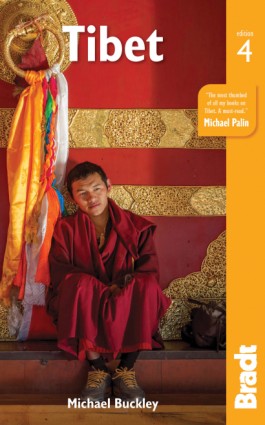Written by Bradt Travel Guides
There are two guaranteed places you will see and meet lots of Tibetans: at festivals and at key pilgrimage sites. You will find temple tripping much more enjoyable if you mingle with Tibetan pilgrims. Important pilgrimage sites are great for seeing people from all parts of Tibet. And interacting with them. Shiny-eyed pilgrims turn out in throngs at the most sacred spots. Here’s our pick of the top seven.
Potala Palace
Lhasa is dominated by the Potala Palace, the winter residence of the Dalai Lama (with his summer palace, the Norbulingka, below). Within the front, walled section of the Potala was the entire Tibetan government administration, where the nobles lived. These buildings have now largely disappeared.
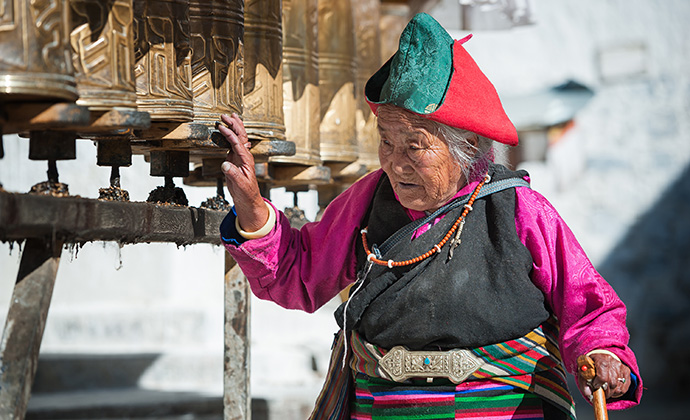
A pilgrim visits Potala Palace © Hung Chung Chih, Shutterstock
Traditionally, Tibetan pilgrims approaching the holy city embarked on four sacred circuits: the inner circuit of the Jokhang Temple (called the Nangkor), the 20-minute outer circuit of the same temple (around the Barkor), a 25-minute circuit of the Potala Palace (called the Tsekor), and a 90-minute circuit around Lhasa itself (called the Lingkor). The first three are eminently possible, but the Lingkor is no longer easy to follow – it has been disrupted by modern Chinese buildings.
The Potala was inscribed on the UNESCO World Heritage list in 1994. The citation says: ‘The Potala, winter palace of the Dalai Lama since the 7th century ad, symbolises Tibetan Buddhism and its central role in the traditional administration of Tibet.’ Chinese authorities conducted a five-year multi-million-dollar restoration of the Potala, completing work in 1995. Why restore a palace that is the former abode of Public Enemy Number One? Because it’s a major tourist attraction, of course – and one that generates millions of dollars in income annually. Unlike the Jokhang or the monasteries around Lhasa, the Potala is run by Chinese tourist authorities: the practice of Buddhism is essentially banned in the palace.
The Potala is a 13-storey castle – rising over 117m high – built of rammed earth, wood and stone. Crowning a mass of solid rock, the maze-like structure contains over a thousand rooms, and is thought to house 10,000 shrines and 200,000 statues. The architecture at first appears to be regular, but is not – storeys are not continuous, and access to halls may be hidden behind pillars or shrines. The walls – varying in thickness between 2m and 5m – were strengthened against earthquakes by pouring in molten copper. No steel frame was used, and no nails were used in the woodwork. The Potala is a layered structure: successive Dalai Lamas worked on the project. Although original construction dates back to the 7th century, the White Palace was not completed until 1653, and the Red Palace not until 1694: at this time, the wheel had not been introduced to Tibet, so stones were lugged in on donkey-back, or on the backs of humans. Simple equipment was used to fashion this skyscraper – an achievement on a par with the building of the pyramids.
The skyscraper itself created a transport problem. The Potala had no plumbing, electricity or heating, so there was a constant stream of porters with water for tea, yak butter for the prayer lamps, and firewood for the fireplaces. The Dalai Lama was portered in and out of the palace in a palanquin; high lamas were piggybacked up to the entrance of the Potala by porters.
The Jokhang
The Jokhang or Tsug Lakhang (central cathedral) is Tibet’s most sacred temple – the heart of Tibet – with streams of pilgrims coursing through. The temple was built in the 7th century by King Songtsen Gampo when he moved his capital to Lhasa. Apart from his three Tibetan wives, the powerful Songtsen Gampo had two wives offered by neighbouring nations – Nepalese queen Tritsun and Chinese Princess Wencheng. The Jokhang was originally designed by Nepalese craftsmen to house a Buddha image brought by the Nepalese queen. Upon Songtsen Gampo’s death, Princess Wencheng switched the statue she had brought (the Jowo Sakyamuni) from the Ramoche Temple to the Jokhang, apparently to hide it from Chinese troops. That’s why one part of the Jokhang (Chapel 13) is called the ‘Chapel where the Jowo was hidden’. In time, the Jowo Sakyamuni statue became the chief object of veneration. The Jokhang was enlarged and embellished by subsequent rulers and Dalai Lamas. Although the building is as old as Lhasa, much of the statuary is quite new. During the Cultural Revolution, the temple was used as a military barracks and a slaughterhouse; later it was used as a hotel for Chinese officials. Much of the statuary was lost, destroyed or damaged, so it has been replaced with newer copies of the originals.
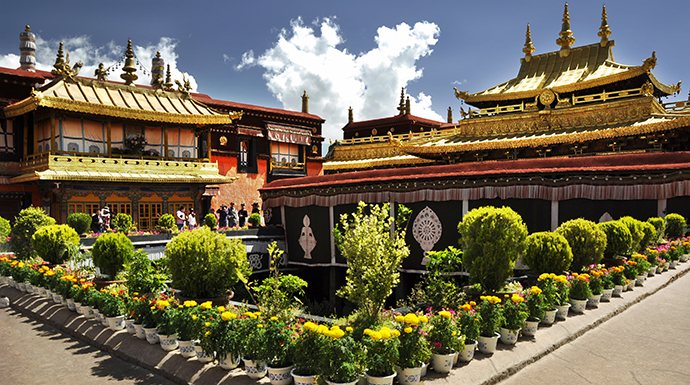
Jokhang Temple was built for the two brides of King Songtsen Gampo © Antony007007, Dreamstime
In 2000, the Jokhang was inscribed on the UNESCO World Heritage list as an addition to the Potala Palace. Initially, this was greeted as good news, as it implied protection of the buildings in the immediate vicinity. However, ancient buildings around the Barkor have since been knocked down and replaced with Chinese copies, on the dubious grounds of superior plumbing and facilities. Then in early 2018, disaster struck: on the second day of Losar, a huge fire broke out in the rooftop area of the Jokhang, causing considerable damage from fire and water.
Barkor Bazaar
Barkor Bazaar is a lively combination of marketplace, pilgrim circuit and ethnic melting pot. The 20-minute hexagonal circuit, running clockwise around the Jokhang and other structures, is always busy, especially at dawn and dusk. Join the pilgrims for a few circuits – it’s good for exercise and for people-watching.
The Barkor has been remodelled to suit Chinese whims: it was completely repaved in 2003 with flatter stones (hence easier to drive over), and a series of Tiananmen-style lamp posts were put up around the circuit, matching those at Potala Square.
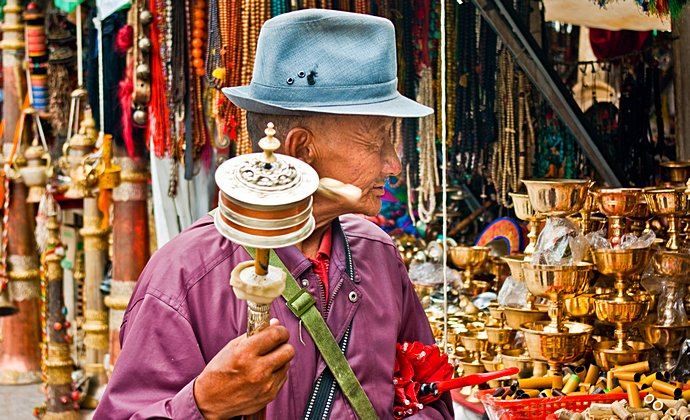
Barkor in Lhasa is one of Tibet’s key sites popular with pilgrims © Antoine Taveneaux CC-BY-SA
At the front of the Jokhang, just inside the temple, you can see some of the original stones. The flagstones are worn smooth, polished from many years of pilgrims performing prostrations. Two-metre-high conical incense burners billow clouds of smoke, and the smell of juniper fills the air. Vendors – mostly Chinese making a buck off Buddhism – sell kata scarves, prayer flags and prayer wheels to the pilgrims. Arriving on pilgrimage from far-flung regions, such as the Kham or Golok areas, pilgrims mutter mantras as they circumambulate. You might see nomad women from eastern Tibet, their long tresses smeared in yak butter; or an old woman leading her favourite sheep around the circuit; or a proud Khampa from eastern Tibet with tassels of red yarn braided through his hair, and a dagger on his belt (not entirely decorative); or a hardy prostrator with rubber apron and padded gloves flinging himself forward on the ground, completing the circuit on his stomach.
The Barkor is a magnet for beggars seeking alms, and for pilgrims seeking funds for their return home (and to support themselves in Lhasa in the meantime). More sophisticated are sutra chanters: for a small sum, they will recite from sacred texts. And finally, there is the bazaar itself – shops and businesses line the entire circuit. Competing with these are open-air stalls laden with souvenirs and household goods; and there are roving vendors with bags of Tibetan music cassettes or other items. Since 1987, Barkor Bazaar has assumed another role – as the focus of protesters who encircle the Barkor when demonstrating against the Chinese occupation of Tibet. This explains the presence of police and security personnel in the area, ready to intercept any demonstrators.
Tashilhunpo Monastery
The Tashilhunpo is the seat of the Panchen Lama, a topic that raises blood pressures on all sides. The monastery is highly sensitive because of the controversy surrounding the 11th Panchen Lama. Pictures of the Chinese-appointed 11th Panchen Lama abound as icons at the monastery, but that’s about all you’ll see of him – he is sequestered in Beijing, supposedly for reasons of education. However, in 2016, he was conscripted to conduct a Kalachakra Empowerment in Shigatse – a ritual that is more often associated with the Dalai Lama. Obviously, Beijing is trying to boost the profile of China’s chosen Panchen Lama. The Dalai Lama’s choice of Panchen Lama has been missing in action since 1995, along with his entire family.
There are monk-stooges hanging about: take care what you do or say here. Tashilhunpo is immense, a monastic city with temples, assembly halls, living quarters and administrative offices. At its height, it housed up to 5,000 monks. Today, the figure is probably closer to 700.
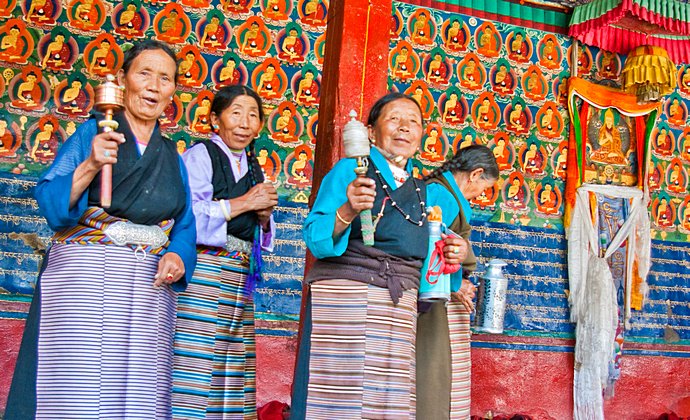
Tashilhunpo Monastery, the traditional seat of successive Panchen Lamas, draws many pilgrims © Antoine Taveneaux CC-BY-SA
As you look northward from the front gates of Tashilhunpo Monastery, you will see several buildings that stand out as taller than the rest. At the back, right wall is an enormous tanka-unfurling the height of a nine-storey building. This is where massive tankas of Buddha are unfurled during summer festivities. To the left of the grounds, the largest building is the Maitreya Chapel: it is here that pilgrims begin their tour of the monastery.
The Maitreya Chapel houses a 26m-high statue of Maitreya, the Buddha of the Future (Champa in Tibetan), seated on a lotus throne with the right hand in a symbolic teaching pose (which looks like an ‘OK’ gesture, in which forefinger and thumb are pressed together in a circle). The statue is gold plated: the structure is made of tons of copper and brass, moulded on a wooden frame. Tibetans believe that Champa will return to preside over the world when all human beings have earned deliverance from suffering. Pilgrims crowd in to make offerings and murmur mantras as they make an inner circuit around the statue itself. The fortress-style building that houses the Maitreya was built from 1914 to 1918 by the Ninth Panchen Lama.
Kailash
Kailash is the centre of the universe – or at least the Tibetan Buddhist universe. In the Tibetan world-view, at the cosmic axis of the universe lies Mount Meru, the abode of the gods. Mount Kailash is thought to be an earthly manifestation of the mythical Meru. Things are not as simple as this, however, as the Tibetan world-view incorporates existence in multiple dimensions. The Tibetan name for Kailash is Kang Rinpoche (Precious Jewel of Snows); the dome-shaped peak is symmetrical like an uncut diamond, with a permanent cap of ice and snow. At 6,714m, the mountain is modest by Himalayan standards, but nevertheless impressive to view. The peak is sacred to Tibetan Buddhist and Bon adherents, and to the Hindus and Jains of India.
The circuit around the sacred mountain is known as the Kailash kora. Tibetans complete the circuit in one long day, starting before dawn and finishing after nightfall. Unless you are super-humanoid, don’t attempt this at altitude. The minimum time for most Westerners to complete the circuit would be two days. Most allow three to four days. If you have a tent and want to dawdle, taking in the landscape at a leisurely pace, plan on five days or more.
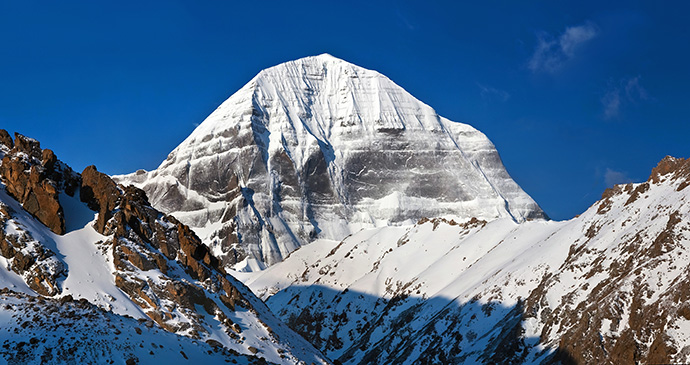
Mount Kailash is a sacred 6,638m peak in western Tibet © Zzvet, Shutterstock
Fellow hikers at Kailash are mainly Indian and Tibetan pilgrims. The Tibetans come from as far away as Kham, usually arriving by ‘pilgrim truck’. Tibetan pilgrims comprise many different nomad groups with a fascinating array of costumes, particularly the women. Women coat their faces in tocha – a cosmetic made of concentrated buttermilk or roots – to protect the skin from dryness and UV rays. Indian pilgrims come as part of a lottery system run by the Delhi government, in operation since the early 1980s. Each year, up to 10,000 Hindus from all parts of India apply. Finalists are chosen and, after fitness tests, this number is whittled down to about a thousand. Hindu pilgrims are allowed ten days in Tibet. Travelling in groups of around 35, the lucky lottery winners walk across Lipu Lek pass where they are met by Chinese guides and the sacred circuit of their dreams gets under way. However, these lottery pilgrims are dwarfed in number by those wealthier Indian pilgrims who reach Kailash as part of 4×4 convoys.
Kumbum Monastery
This large monastic complex is located 26km southwest of Xining. Kumbum (Taersi in Chinese) is the most famous monastery in Amdo and one of the six great Geluk monasteries of the Tibetan plateau. In its prime, Kumbum once housed 3,000 monks, but under Chinese rule it was closed down for a period. Since it reopened in 1979 the monastery has housed about 400 monks, with half the buildings functioning in museum mode. The former abbot, Ajia Rinpoche, fled in 1998 to seek asylum in the USA: he was the highest-ranking monk in the Chinese Communist Party.
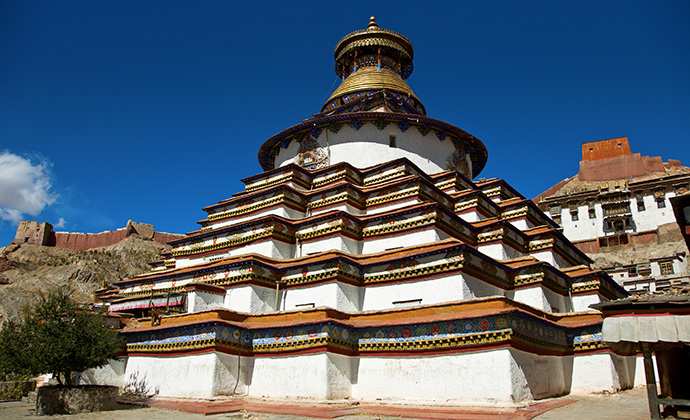
At its peak, Kumbum Monastery was home to 3,000 monks © Kenneth-Dedeu, Shutterstock
Situated in the largely Muslim county of Huangzhong, the temples here were protected during the Cultural Revolution and contain some of the greatest artworks of Amdo. However, Kumbum is a major Chinese destination, and the monks are tightly controlled, which affects the atmosphere.
Kumbum is the birthplace of Tsongkhapa, founder of the Gelukpa sect in the early 15th century. Inside a spectacular green-tiled building is a silver pagoda containing the earthly belongings of Tsongkhapa. The monastery is thought to have been built (in the 16th century) around a legendary pipal tree, said to bear a Buddha-like image on every leaf. The tree is accredited with magical powers. The temple is famed, too, for its elaborate yak-butter sculptures – in the shape of animals, landscapes and religious figures – which can reach 15m in length. Festivals at Kumbum attract large numbers of Tibetan pilgrims. Because Kumbum is easily accessed (being so close to Xining) it unfortunately also attracts large numbers of Chinese tourists, who stand next to cardboard cut-outs to have pictures taken. The monastery has a disturbingly commercialised air about it. The best time to visit is during a festival: tour agents in the Xining hotels can tell you of any upcoming festivals.
Labrang Monastery
Labrang Monastery was founded in 1709 and rapidly grew to become one of the six great Gelukpa monasteries. The main assembly hall was rebuilt after being destroyed by fire in 1985, but most of the other halls survived the Cultural Revolution relatively intact, and contain beautiful works of art. You will most likely see elaborate yak-butter sculptures. The monks’ quarters have been rebuilt in recent years and some are spacious and comfortable. A 3km kora lined with prayer wheels surrounds the complex and is well worth the walk. The temples and colleges of Labrang can only be visited on a morning or afternoon official tour. Labrang acts as a major teaching centre and monks come from not only the 108 satellite gompas scattered throughout nearby counties, but also from central Tibet and Mongolia. Thus the number of monks is somewhat fluid, although there are likely to be around 2,000 here. There is also a small nunnery and Nyingma temple on the far side of the complex. You can be sure that with such a large contingent of monks, the Chinese keep a close eye on proceedings. Surveillance was stepped up upon the arrival of the Chinese-appointed Panchen Lama to take up residence in 2011 – in an attempt to legitimise his religious role.
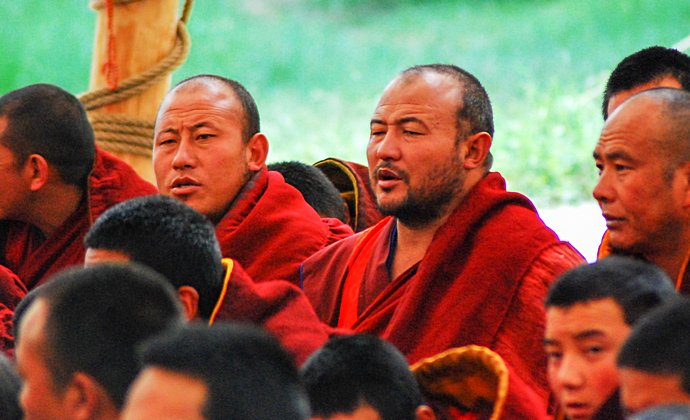
The number of monks at Labrang Monastery fluctuates but there are usually around 2,000 © Shizhao CC-BY-SA
At a cool 2,900m, Xiahe makes an excellent base for hiking. Foreigners tend to stay longer than intended at Labrang, not only because of the monastery and Western food, but also because of the opportunity to see the surrounding hills and grasslands. Bikes can be hired to reach the Sangke grasslands region, where picnics are available in Tibetan-style tents, and where horses can be hired. The nearby hills offer good opportunities for day walks, and you may be offered butter tea and yoghurt if you reach the nomad camps higher up, but beware of dogs!
Inspired to visit Tibet? Check out our guide for more information:
